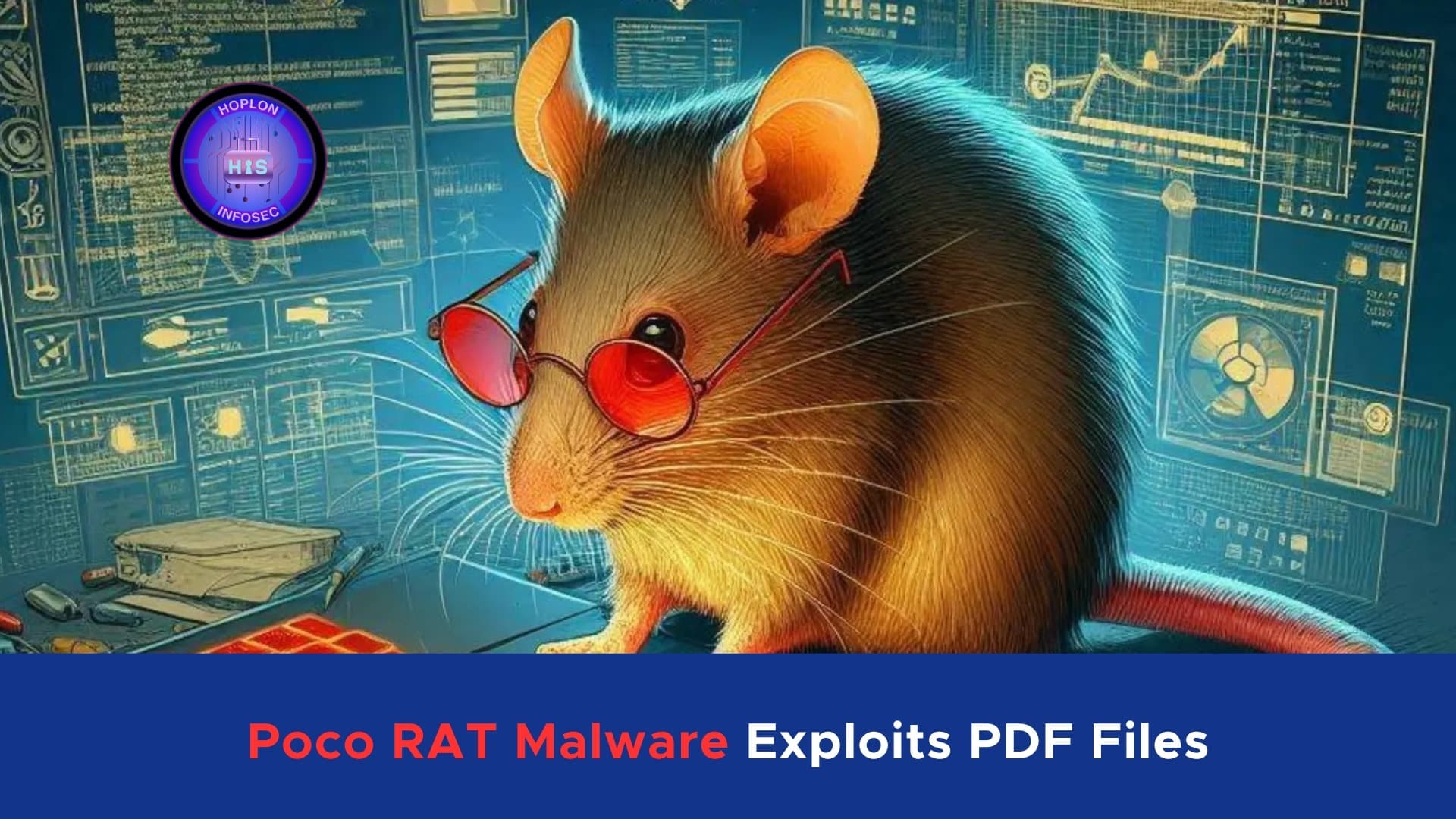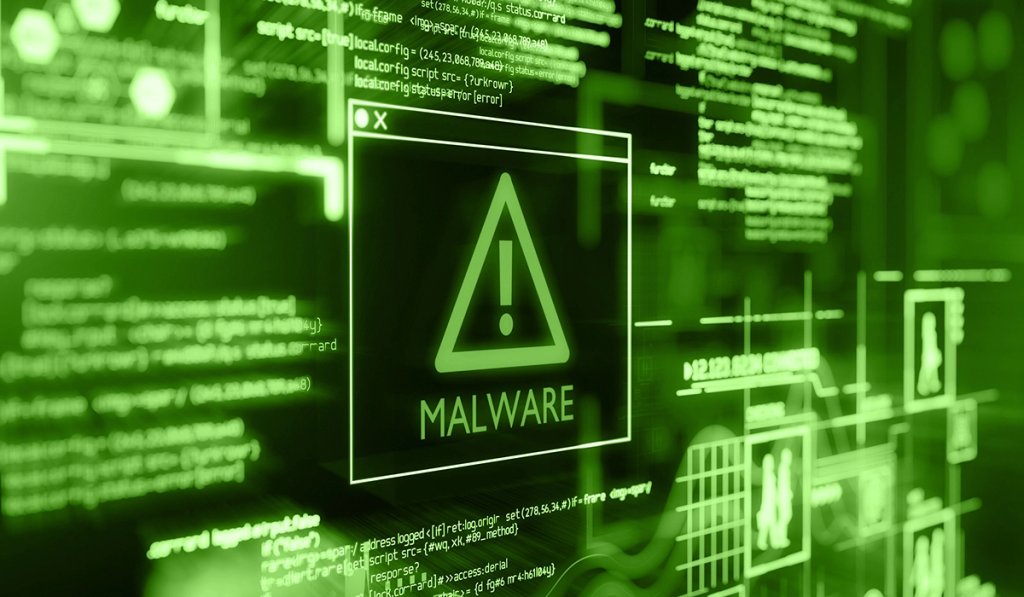Poco RAT Malware Exploiting PDF Files and Steal Data

Hoplon InfoSec
28 Feb, 2025
Recently, a new variant of the Poco RAT malware has emerged as a significant threat, mainly targeting Spanish-speaking organizations across Latin America. This new iteration leverages advanced techniques such as sophisticated PDF decoys and cloud-based delivery systems to infiltrate networks and exfiltrate sensitive data. In this comprehensive analysis, we will explore the origins, tactics, technical innovations, and broader implications of this malware campaign and provide recommendations for organizations looking to bolster their defenses.
Introduction to the Poco RAT malware
In today’s interconnected world, cyberattacks are becoming more frequent and diverse. One of the latest threats involves the deployment of a new Poco RAT variant that has caught the attention of cybersecurity professionals due to its innovative methods and the breadth of its target range. This malware is particularly notable for its association with the cyber-mercenary group Dark Caracal, a name that has surfaced in several high-profile attacks over recent years. Previously linked to the Bandook remote access trojan, the new variant signifies a deliberate evolution in tactics, now repurposing familiar techniques for broader phishing operations and financial espionage.
The Rise of the New Poco RAT Variant
The new variant of Poco RAT marks a significant shift in cyber adversaries’ methods. While earlier versions of related malware primarily focused on stealthy data collection and limited lateral movement, this updated version is designed for rapid spread and aggressive financial targeting. By adapting the strategies of the notorious Bandook trojan, attackers have repurposed established techniques and refined them to evade modern detection systems. The evolution from Bandook to Poco RAT illustrates the attackers’ commitment to staying ahead of security defenses and constantly adapting to the changing threat landscape.
Understanding the Attack Chain
Phishing as the First Line of Attack
The campaign begins with a highly targeted phishing strategy. Attackers craft emails that appear legitimate financial notifications, often mentioning unpaid invoices or tax-related documents. These emails are meticulously designed to exploit recipients’ trust in communications from financial institutions or government bodies. By referencing issues such as overdue payments or important regulatory documents, the emails prompt a sense of urgency and fear, compelling recipients to take immediate action without verifying the message’s legitimacy.
PDF Decoys: Mimicking Trusted Documents
A key element in the attack chain is the use of PDF decoys. These PDFs are not random but are carefully constructed to mimic documents from reputable organizations. For example, attackers have used the branding and visual style of well-known Venezuelan banks such as BBVA Provincial and prominent industrial firms like Global Supply Services. The PDFs incorporate blurred graphics and metadata fields that list common Spanish-language names, such as “Rene Perez” and “Keneddy Cedeño,” further enhancing their authenticity. This level of detail is designed to help the documents pass through initial scrutiny, reducing the likelihood that antivirus programs will flag them as malicious.
Cloud-Based Delivery Systems
Once a victim opens the decoy PDF, they are redirected to a shortened URL. This URL is not random; it leads to malicious .rev archive files hosted on reputable cloud storage platforms such as Google Drive and Dropbox. By exploiting users’ inherent trust in these cloud services, attackers ensure that their payloads are delivered with minimal suspicion. These .rev files initially intended to repair corrupted archives have been repurposed to serve as the dropper for Poco RAT. The malware avoids leaving traces on the disk by directly injecting its executable code into legitimate processes, such as iexplore.exe, further complicating detection and forensic analysis.
Technical Evasion: How the Malware Stays Hidden

Multi-Layered Obfuscation Techniques
Dark Caracal’s new tools employ an impressive array of technical evasion techniques. One of the primary methods is dynamic API resolution, which allows the malware to hide its malicious function calls from static analysis tools. By resolving functions at runtime, the malware avoids the common pitfalls that trigger alerts in antivirus systems. In addition, the malware uses Twofish encryption with per-build keys to secure its embedded strings, ensuring that the instructions remain hidden from prying eyes even if parts of the code are extracted.
Exception-Handler Hijacking
Another innovative tactic employed by this new variant is exception-handler hijacking. This technique allows the malware to redirect code execution to bypass traditional debugging methods. When an exception occurs, instead of the system handling it in the usual manner, the malware intercepts the exception and manipulates the process flow to continue operating undetected. This method is particularly effective against security software that relies on monitoring system exceptions to identify abnormal behavior.
Expanding the Target Spectrum
Shifting Focus: From Limited to Broad-Scale Attacks
Historically, cybercriminal groups have often concentrated on specific sectors with a high potential return on investment. However, recent attacks using this Poco RAT variant indicate a broader scope. Approximately 49% of recent attacks have been directed toward technology firms, marking a significant 33% increase compared to previous years. This shift suggests that cyber adversaries are now actively targeting industries where intellectual property and sensitive operational data can be exploited for competitive advantage or financial gain.
Financial and Manufacturing Sectors Under Siege
In addition to technology firms, financial organizations, and manufacturing enterprises have also emerged as key targets. Financial institutions, which account for around 10% of the targeted sectors, are beautiful due to their wealth of transaction records and customer data. Similarly, manufacturing companies, representing about 10% of recent attacks, are targeted for their intellectual property and sensitive production data. These shifts in targeting strategies underline the attackers’ adaptability and willingness to diversify their attack portfolio to maximize impact.
A Comprehensive Look at Poco RAT’s Espionage Toolkit
Environmental Profiling for Maximum Impact
Once the malware is deployed, it embarks on a comprehensive reconnaissance mission. One of the first tasks it performs is environmental profiling. This process involves scanning the victim’s system to gather crucial information to inform further actions. For instance, the malware checks for the presence of virtualization software by searching for specific registry keys (such as SOFTWARE\Oracle\VirtualBox) or scanning for ports typically associated with virtualization tools like VMware’s 0×5658. This step ensures the malware can determine whether it operates in a genuine environment or a sandbox to analyze malicious software.
Detailed Data Collection Mechanisms
Poco RAT is designed to be a versatile espionage tool. It collects a wide range of data, including usernames, operating system versions, and RAM metrics. The data is then structured into detailed reports using unique delimiters such as “@&)” to separate different fields. This structured reporting enables attackers to parse and analyze the stolen information quickly, allowing them to identify the most valuable targets within an organization and tailor their subsequent attacks accordingly.
Command and Control Communication
Maintaining persistent communication with the attacker’s command and control (C2) infrastructure is critical for the success of this campaign. Poco RAT uses a series of heartbeat messages to communicate with remote IP addresses, such as 193.233.203.63. These messages are sent through a range of ports—from 6211 to 6543—to avoid detection and blocking by network security devices. This dynamic port cycling ensures that even if one port is blocked, the malware can continue to operate by switching to an alternative port, thereby maintaining a steady flow of information back to the attackers.
Advanced Command Execution Capabilities
The malware is not just a passive data collector but has robust command execution capabilities. These include functions such as screen capture, fileless payload execution, and providing access to the command prompt. Such features allow attackers to monitor the victim’s activities and execute additional commands, deploy further malware, or pivot to other systems within the network. These capabilities transform Poco RAT from a simple espionage tool into a full-fledged remote access trojan capable of facilitating various malicious activities.
Infrastructure Synergy with Legacy Bandook Operations
Shared Infrastructure: A Key to Smooth Transitions
One of the most revealing aspects of this campaign is the apparent infrastructure synergy between the new Poco RAT variant and legacy Bandook operations. An analysis by the cybersecurity firm Positive Technologies revealed overlapping infrastructure elements between the two malware families. For example, specific autonomous systems such as AS200019 (AlexHost SRL) have been identified as hosts for Poco RAT and Bandook command and control servers. Another autonomous system, AS44477 (Stark Industries Ltd.), has similarly been used by both malware families since 2023. This shared infrastructure facilitates a smoother transition between malware campaigns and provides attackers with a robust framework for rapid deployment and operational scalability.
The Impact on Malware Proliferation
The benefits of this infrastructure synergy are evident in the malware’s increased prevalence. Samples of Poco RAT have seen a 36% year-over-year increase compared to Bandook, with 483 samples identified versus 355 from previous campaigns. This growth underscores the attackers’ strategic success in leveraging existing resources while innovating new techniques. It also highlights the pressing need for organizations to adopt more comprehensive cybersecurity measures to detect and mitigate such sophisticated threats.
Implications for Organizations and Cybersecurity Best Practices

The Evolving Threat Environment
The emergence of this new Poco RAT variant is a stark reminder of how rapidly the threat environment can evolve. Cyber adversaries are constantly refining their techniques, often repurposing older tools and blending them with new methods to create hybrid threats that are more difficult to detect and counter. Organizations, particularly those in regions where Spanish is the primary language, must remain vigilant and proactive in their cybersecurity strategies. The use of trusted cloud services by attackers, as seen in this campaign, further complicates efforts to secure digital environments, as it blurs the line between legitimate and malicious activity.
Strengthening Defense-in-Depth Strategies
Given the complexity and adaptability of the new Poco RAT variant, relying on a single layer of defense is no longer sufficient. Instead, organizations should adopt a defense-in-depth strategy that combines technical controls with robust user education programs. For example, implementing advanced email filtering and threat detection systems can help identify suspicious messages before they reach end users. At the same time, regular cybersecurity training can empower employees to recognize and report potential phishing attempts, reducing the likelihood that a carefully crafted decoy PDF will succeed in its mission.
Enhanced Monitoring and Incident Response
In addition to proactive defense measures, organizations must establish comprehensive monitoring and incident response protocols. Continuous network monitoring can help detect abnormal behaviors, such as unexpected outbound communications on non-standard ports, which may indicate the presence of a compromised system. Furthermore, having a well-documented incident response plan in place ensures that the organization can quickly isolate affected systems, contain the threat, and begin remediation processes to limit further damage in the event of a breach.
Leveraging Threat Intelligence and Collaboration
The rapid evolution of malware like Poco RAT underscores the importance of leveraging threat intelligence from reputable sources. Organizations should participate in information-sharing networks with other companies and cybersecurity experts to stay informed about the latest threats and effective countermeasures. By collaborating and sharing insights, businesses can build a collective defense better equipped to deal with sophisticated cyberattacks. This collective approach enhances individual and organizational resilience and contributes to a more secure digital ecosystem across industries and regions.
Concluding Thoughts: Navigating an Evolving Cyber Threat Landscape

The new variant of Poco RAT represents a significant milestone in the ongoing arms race between cyber adversaries and cybersecurity defenders. By combining advanced techniques such as sophisticated PDF decoys, cloud-based delivery systems, and dynamic evasion methods, Dark Caracal has elevated its game to target a broader range of industries and organizations in Latin America. The evolution from Bandook to Poco RAT indicates that attackers continuously innovate and adapt their tactics to exploit vulnerabilities in modern security architectures.
This emerging threat reinforces the need for comprehensive cybersecurity strategies that incorporate multiple layers of defense, ongoing employee training, and robust incident response protocols. It is essential to adopt a proactive approach—one that anticipates potential threats and is agile enough to respond swiftly when an attack is detected. By staying informed about the latest developments in cyber threats and collaborating with industry peers, organizations can significantly reduce the risks posed by sophisticated malware such as Poco RAT.
In an era where the digital battlefield is constantly shifting, the emergence of the new Poco RAT variant serves as both a warning and a call to action. While attackers refine their methods and leverage existing infrastructures to maximize impact, organizations must evolve their defenses accordingly. Only through technical innovation, rigorous monitoring, and a culture of cybersecurity awareness can businesses hope to withstand the challenges posed by this evolving threat landscape.
As the campaign unfolds, cybersecurity professionals and organizations alike must remain vigilant. The ability of malware to exploit trusted services and evade detection highlights the pressing need for continuous improvement in security practices. Ultimately, the battle against cyber threats is a dynamic and ongoing challenge that requires collaboration, foresight, and the willingness to adapt in the face of ever-changing tactics.
In summary, the emergence of this new Poco RAT variant is not just a technical evolution in malware design but a stark reminder of the relentless innovation exhibited by cyber adversaries. By understanding the mechanisms behind the attack chain, recognizing the technical evasion techniques, and appreciating the broader implications for industry sectors, organizations can better prepare themselves for the realities of modern cyber warfare. It is incumbent upon every business, especially those operating in high-risk regions, to take these threats seriously and implement robust measures that defend against current attacks and anticipate future challenges.
By weaving together technical insight, detailed analysis, and strategic recommendations, this in-depth examination of the Poco RAT variant aims to provide a comprehensive resource for understanding and mitigating one of today’s most advanced malware threats. The road ahead may be fraught with challenges. Still, with informed decision-making and a commitment to robust cybersecurity practices, organizations can navigate this perilous landscape with greater confidence and resilience.
The evolution of cyber threats, such as the new Poco RAT variant, emphasizes the critical need for continuous improvement in technology and strategy. The importance of a well-rounded, layered defense cannot be overstated in a world where cyber adversaries constantly refine their tools and tactics. As organizations remain on guard against these sophisticated threats, the insights provided here can be a foundation for developing more resilient cybersecurity measures that protect valuable data, preserve operational integrity, and secure digital assets against future attacks.
In conclusion, while the sophistication and reach of this malware campaign are alarming, the proactive adoption of advanced security protocols and a vigilant cybersecurity posture can make a significant difference. The ongoing battle between attackers and defenders is an ever-evolving one, and by staying informed and prepared, organizations can effectively mitigate the risks posed by threats like the new Poco RAT variant.
More at:
https://cybersecuritynews.com/poco-rat-malware-exploits-pdf-files/
Share this :